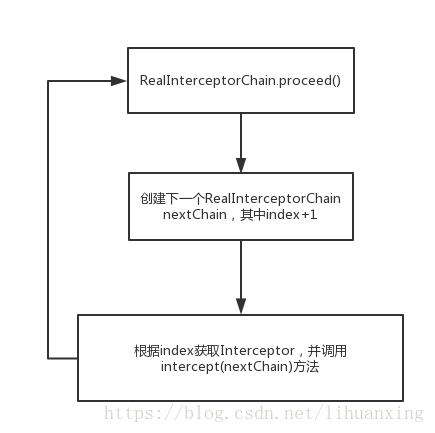上一篇讲到OkHttp的整体流程,但是里面有一个很重要的方法getResponseWithInterceptorChain还没有讲到,这个方法里面包括了整个okHttp最重要的拦截器链,所以我们今天来讲解一下。
Response getResponseWithInterceptorChain() throws IOException {
// Build a full stack of interceptors.
List<Interceptor> interceptors = new ArrayList<>();
interceptors.addAll(client.interceptors());
interceptors.add(retryAndFollowUpInterceptor);
interceptors.add(new BridgeInterceptor(client.cookieJar()));
interceptors.add(new CacheInterceptor(client.internalCache()));
interceptors.add(new ConnectInterceptor(client));
if (!forWebSocket) {
interceptors.addAll(client.networkInterceptors());
}
interceptors.add(new CallServerInterceptor(forWebSocket));
Interceptor.Chain chain = new RealInterceptorChain(interceptors, null, null, null, 0,
originalRequest, this, eventListener, client.connectTimeoutMillis(),
client.readTimeoutMillis(), client.writeTimeoutMillis());
return chain.proceed(originalRequest);
}
这里创建了一个拦截器list的集合,首先会把用户自定义的拦截器(应用程序拦截器),和okhttp内部提供的拦截器添加进去,而接下来我们着重讲解的是okhttp内部提供的这5个拦截器。然后在第13行这里,创建了一个RealInterceptorChain的一个实例,在这个实例里面把我们刚刚添加完的list集合传递进去,还有一个index值为0也传递进去(这个非常重要),还有request。最后就是调用这个chain的proceed方法,而这个拦截器链式如何运转,秘密应该就是在这个方法里面了,我们就继续往下看:
@Override public Response proceed(Request request) throws IOException {
return proceed(request, streamAllocation, httpCodec, connection);
}
public Response proceed(Request request, StreamAllocation streamAllocation, HttpCodec httpCodec,
RealConnection connection) throws IOException {
if (index >= interceptors.size()) throw new AssertionError();
calls++;
// If we already have a stream, confirm that the incoming request will use it.
if (this.httpCodec != null && !this.connection.supportsUrl(request.url())) {
throw new IllegalStateException("network interceptor " + interceptors.get(index - 1)
+ " must retain the same host and port");
}
// If we already have a stream, confirm that this is the only call to chain.proceed().
if (this.httpCodec != null && calls > 1) {
throw new IllegalStateException("network interceptor " + interceptors.get(index - 1)
+ " must call proceed() exactly once");
}
// Call the next interceptor in the chain.
RealInterceptorChain next = new RealInterceptorChain(interceptors, streamAllocation, httpCodec,
connection, index + 1, request, call, eventListener, connectTimeout, readTimeout,
writeTimeout);
Interceptor interceptor = interceptors.get(index);
Response response = interceptor.intercept(next);
// Confirm that the next interceptor made its required call to chain.proceed().
if (httpCodec != null && index + 1 < interceptors.size() && next.calls != 1) {
throw new IllegalStateException("network interceptor " + interceptor
+ " must call proceed() exactly once");
}
// Confirm that the intercepted response isn't null.
if (response == null) {
throw new NullPointerException("interceptor " + interceptor + " returned null");
}
if (response.body() == null) {
throw new IllegalStateException(
"interceptor " + interceptor + " returned a response with no body");
}
return response;
}
看到它这里会继续调用它的proceed重载方法,然后看第19行,它这里又创建了一个新的拦截器,而这个拦截器链跟刚才创建的有什么区别呢?就是传进去的index值是index+1,这样子如果我们下次要进行访问的话,就只能从下一个拦截器进行访问,这样子就可以把我们的整个拦截器构成一个链条。下一行就是获取索引index的拦截器,然后再调用拦截器的intercept方法,并且将刚刚创建好的next拦截器链传递进去。为了分析我们整个拦截器链的流程,我们对第一个拦截器RetryAndFollowUpInterceptor的intercept方法进行粗略分析。
response = realChain.proceed(request, streamAllocation, null, null);
这里这个realChain就是之前创建好的next拦截器链,这里会继续它的proceed方法。调用了proceed方法之后,又会继续创建下一个拦截器链,并且获取当前的拦截器,这样子就构成了我们整个拦截器链的工作流程。

而在拦截器里面,主要是三个步骤:
1、请求前对request进行处理
2、继续调用下一个拦截器而获取response
3、对response进行处理,返回给上一个拦截器
上面讲完了整个拦截器链的工作流程,我们接下来分析各个拦截器的工作流程。
从名字上可以看得出,它是重定向拦截器,失败重连的。我们来看看它的intercept方法:
@Override public Response intercept(Chain chain) throws IOException {
Request request = chain.request();
RealInterceptorChain realChain = (RealInterceptorChain) chain;
Call call = realChain.call();
EventListener eventListener = realChain.eventListener();
StreamAllocation streamAllocation = new StreamAllocation(client.connectionPool(),
createAddress(request.url()), call, eventListener, callStackTrace);
this.streamAllocation = streamAllocation;
int followUpCount = 0;
Response priorResponse = null;
while (true) {
if (canceled) {
streamAllocation.release();
throw new IOException("Canceled");
}
Response response;
boolean releaseConnection = true;
try {
response = realChain.proceed(request, streamAllocation, null, null);
releaseConnection = false;
} catch (RouteException e) {
// The attempt to connect via a route failed. The request will not have been sent.
if (!recover(e.getLastConnectException(), streamAllocation, false, request)) {
throw e.getLastConnectException();
}
releaseConnection = false;
continue;
} catch (IOException e) {
// An attempt to communicate with a server failed. The request may have been sent.
boolean requestSendStarted = !(e instanceof ConnectionShutdownException);
if (!recover(e, streamAllocation, requestSendStarted, request)) throw e;
releaseConnection = false;
continue;
} finally {
// We're throwing an unchecked exception. Release any resources.
if (releaseConnection) {
streamAllocation.streamFailed(null);
streamAllocation.release();
}
}
// Attach the prior response if it exists. Such responses never have a body.
if (priorResponse != null) {
response = response.newBuilder()
.priorResponse(priorResponse.newBuilder()
.body(null)
.build())
.build();
}
Request followUp = followUpRequest(response, streamAllocation.route());
if (followUp == null) {
if (!forWebSocket) {
streamAllocation.release();
}
return response;
}
closeQuietly(response.body());
if (++followUpCount > MAX_FOLLOW_UPS) {
streamAllocation.release();
throw new ProtocolException("Too many follow-up requests: " + followUpCount);
}
if (followUp.body() instanceof UnrepeatableRequestBody) {
streamAllocation.release();
throw new HttpRetryException("Cannot retry streamed HTTP body", response.code());
}
if (!sameConnection(response, followUp.url())) {
streamAllocation.release();
streamAllocation = new StreamAllocation(client.connectionPool(),
createAddress(followUp.url()), call, eventListener, callStackTrace);
this.streamAllocation = streamAllocation;
} else if (streamAllocation.codec() != null) {
throw new IllegalStateException("Closing the body of " + response
+ " didn't close its backing stream. Bad interceptor?");
}
request = followUp;
priorResponse = response;
}
}
我们看到第6行这里创建了一个StreamAllocation,这个是用于获取连接服务器的connection和数据传输的输入输出流。虽然这个实例是在这里创建,但是它并不是在这个拦截器里面执行,而是一步一步往下传递,到后面的拦截器才会被执行。
在第19行这里就会调用realChain.proceed,会继续调用下一个拦截器去获取response。既然是失败重连,那这里又是怎样实现失败重连的呢?我们看一下这里:
Request followUp = followUpRequest(response, streamAllocation.route());
if (followUp == null) {
if (!forWebSocket) {
streamAllocation.release();
}
return response;
}
if (++followUpCount > MAX_FOLLOW_UPS) {
streamAllocation.release();
throw new ProtocolException("Too many follow-up requests: " + followUpCount);
}
如果获取的response是符合条件的话,就会直接把这个response返回。如果不符合条件的话,就会继续往下走,这里有一个MAX_FOLLOW_UPS变量,这个变量是在这个拦截器里面定义的。
private static final int MAX_FOLLOW_UPS = 20;
因为我们重连也不可能无休止地进行重连,所以okhttp这里就规定了重连的次数最多只能是20次。
@Override public Response intercept(Chain chain) throws IOException {
Request userRequest = chain.request();
Request.Builder requestBuilder = userRequest.newBuilder();
RequestBody body = userRequest.body();
if (body != null) {
MediaType contentType = body.contentType();
if (contentType != null) {
requestBuilder.header("Content-Type", contentType.toString());
}
long contentLength = body.contentLength();
if (contentLength != -1) {
requestBuilder.header("Content-Length", Long.toString(contentLength));
requestBuilder.removeHeader("Transfer-Encoding");
} else {
requestBuilder.header("Transfer-Encoding", "chunked");
requestBuilder.removeHeader("Content-Length");
}
}
if (userRequest.header("Host") == null) {
requestBuilder.header("Host", hostHeader(userRequest.url(), false));
}
if (userRequest.header("Connection") == null) {
requestBuilder.header("Connection", "Keep-Alive");
}
// If we add an "Accept-Encoding: gzip" header field we're responsible for also decompressing
// the transfer stream.
boolean transparentGzip = false;
if (userRequest.header("Accept-Encoding") == null && userRequest.header("Range") == null) {
transparentGzip = true;
requestBuilder.header("Accept-Encoding", "gzip");
}
List<Cookie> cookies = cookieJar.loadForRequest(userRequest.url());
if (!cookies.isEmpty()) {
requestBuilder.header("Cookie", cookieHeader(cookies));
}
if (userRequest.header("User-Agent") == null) {
requestBuilder.header("User-Agent", Version.userAgent());
}
Response networkResponse = chain.proceed(requestBuilder.build());
HttpHeaders.receiveHeaders(cookieJar, userRequest.url(), networkResponse.headers());
Response.Builder responseBuilder = networkResponse.newBuilder()
.request(userRequest);
if (transparentGzip
&& "gzip".equalsIgnoreCase(networkResponse.header("Content-Encoding"))
&& HttpHeaders.hasBody(networkResponse)) {
GzipSource responseBody = new GzipSource(networkResponse.body().source());
Headers strippedHeaders = networkResponse.headers().newBuilder()
.removeAll("Content-Encoding")
.removeAll("Content-Length")
.build();
responseBuilder.headers(strippedHeaders);
String contentType = networkResponse.header("Content-Type");
responseBuilder.body(new RealResponseBody(contentType, -1L, Okio.buffer(responseBody)));
}
return responseBuilder.build();
}
这个拦截器主要的作用就是设置我们的内容长度,编码方式,压缩,添加头部信息等。
当获取到response之后,看到最后有一个if的判断,transparentGzip是在我们的设置“Accept-Encoding”时赋值的,这个标志位其实就是告诉服务器我们客户端是支持gzip压缩的,那么这样子服务器才会返回一个支持gzip压缩的response回来。第二个判断其实就是判断服务器返回来的Response是否经过了gzip压缩,根据“Content-Encoding”进行判断。第三个条件就是判断Http头部是否有body。当三个条件都符合的情况下,我们就会将返回的response的body体的输入流转化为GzipSource,这样子的目的就是我们用户可以直接以解压的方式读取这个数据流。
这样子就讲完了前两个拦截器,后面会继续讲解剩下的三个拦截器OkHttp源码解析(三),谢谢!








 本文深入剖析OkHttp的拦截器链机制,讲解getResponseWithInterceptorChain方法,详细解读RetryAndFollowUpInterceptor与BridgeInterceptor的工作原理及流程。
本文深入剖析OkHttp的拦截器链机制,讲解getResponseWithInterceptorChain方法,详细解读RetryAndFollowUpInterceptor与BridgeInterceptor的工作原理及流程。
















 524
524

 被折叠的 条评论
为什么被折叠?
被折叠的 条评论
为什么被折叠?








